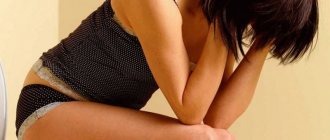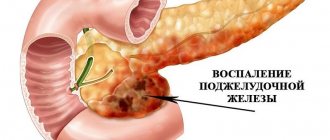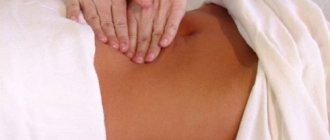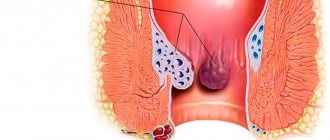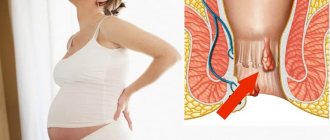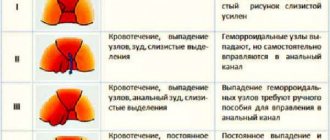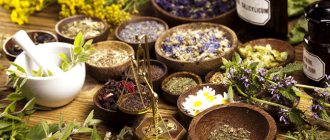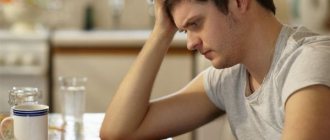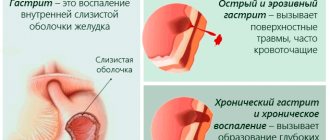Causes of inflammation of hemorrhoids
The basis of hemorrhoids is the formation of hemorrhoidal cones, which, in fact, are dilated and deformed cavernous veins of the anorectal region.
Experts believe that the main reason for the formation of hemorrhoidal cones is dysfunction of the cavernous veins and venous congestion, which arise under the influence of a number of unfavorable factors.
Cavernous veins cannot cope with active blood flow due to the weakness of their walls, as a result of which they expand and become deformed, transforming first into protrusions of the rectal canal, and over time into large nodes.
In the initial stages of the disease, hemorrhoids are small and therefore do not bring any subjective sensations to the patient. But in the absence of adequate treatment, their size increases so much that they begin to fall out of the anus and become inflamed. At the same time, inflammation of the external nodes can be observed in patients with hemorrhoids from the first days of the disease.
If hemorrhoids become inflamed, the following factors could contribute to this:
- chronic constipation . The hemorrhoidal node most often becomes inflamed due to injury from hard feces that have formed due to constipation. In addition, constipation often causes anal tears, which also negatively affects the condition of hemorrhoids;
- excessive physical activity associated with heavy lifting. This factor leads to increased pressure inside the abdominal cavity, and, consequently, to dysfunction and inflammation of the cavernous veins;
- pregnancy and natural childbirth . This is the most common cause of inflammation of hemorrhoids in women;
- prolonged sitting . Sedentary work also promotes active blood flow to the hemorrhoidal veins;
- alcohol abuse . Alcohol increases blood pressure, including in the vessels of the rectum;
- unbalanced diet . The predominance of protein foods in the diet and a deficiency of plant fibers contribute to constipation, which in turn causes inflammation of hemorrhoids;
- ignoring the rules of hygiene of the anorectal area . Visiting baths, saunas and too hot baths, as well as using low-quality toilet paper, contribute to inflammation of hemorrhoids.
A patient with hemorrhoids must understand that inadequate or untimely treatment also contributes to the progression of the disease and the actual inflammation of the hemorrhoids. Therefore, at the first signs of hemorrhoidal disease, you need to contact a specialist - a proctologist, and not self-medicate.
What causes hemorrhoids to become inflamed?
The root cause of the development of pathology is damage to the walls of the anal venous vessels, weakening of their tone, which is a symptom of impaired systemic circulation. Hemorrhoidal nodules appear as a result of damage to blood vessels, blood flow does not pass fully and deformation, compaction, and protrusion of hemorrhoidal veins occur. If the node in the anus is inflamed, then the patient has already missed the first degree of pathology and did not begin to treat the disease in time.
The acute inflammatory process does not occur immediately; it is preceded by several stages of hemorrhoid development. The most common pathogenetic factors for the onset of the disease are:
- Constipation, which leads to damage by hard feces to the hemorrhoid during bowel movements. Small wounds often become inflamed and cause complications of the disease;
- When lifting weights or prolonged heavy physical work, intraperitoneal pressure increases, which provokes an exacerbation of the condition.
- Carrying a child, childbirth. This is one of the most common factors in the development of the inflammatory process in girls.
- Passion for alcohol, smoked, spicy, fatty, salty foods. For this reason, inflammation of hemorrhoids often begins during feasts and celebrations.
- Poor hygiene of the rectum and perianal area. Coarse toilet paper and frequent bathing in hot water can lead to the development of the disease.
Inflammation of the hemorrhoid: symptoms
With inflammation of hemorrhoids, patients may complain of the following:
- feeling of incomplete bowel movement;
- burning and itching in the anus, especially after bowel movements;
- pain in the rectum, which increases during bowel movements, walking, sitting on a hard chair, etc.;
- secretion of mucus from the anus, which discharges the skin of the perianal folds;
- hemorrhoidal bleeding of varying intensity, which is provoked by defecation;
- swelling of the tissues of the anus.
If hemorrhoids worsen, you must immediately consult a specialist - a proctologist, to quickly relieve inflammation. Neglect of the first symptoms of the disease can lead to dangerous complications that pose a serious threat to your health.
Ways to treat bleeding at home
If you don’t start fighting in time, inflammation of the hemorrhoids inside the rectum will begin. It is recommended to use useful methods:
- The first method includes the use of tablets, ointments, and suppositories. Ointments and suppositories will relieve pain symptoms and heal rectal cracks. The tablets strengthen the walls of the anus and normalize blood circulation.
- The second includes treatment with folk remedies. This effective method does not cause side effects.
First aid at home:
- Go to bed and limit activity. Stay calm - overexertion makes the situation worse.
- When defecating, you should not push. Leads to prolapse of hemorrhoids and increases rectal bleeding.
- If hemorrhoids worsen, stick to your diet. Forbidden foods: spicy, heavy and salty foods, alcohol and flour. Increase your consumption of foods containing fiber: vegetable oils, nuts, juices, cereals and cereals, vegetables, fruits and dried fruits.
- Will help in the treatment of enema disease.
- Wash yourself with water more often and take baths.
- Take laxative pills.
- Use soft toilet paper. Moisten with water before use.
- Do not lift weights, avoid heavy physical activity.
How to recognize the inflammatory process in hemorrhoids?
An experienced proctologist will be able to identify inflamed hemorrhoids during the initial examination.
After collecting complaints and anamnesis of the disease, the specialist begins to examine the patient externally, in particular the anorectal area, and conducts a rectal digital examination. Now let's look at what the signs are for external and internal hemorrhoids.
Signs of inflammation of the external hemorrhoid
External hemorrhoids are varicose veins and deformation of the saphenous hemorrhoidal veins, which are located around the anal ring below the dentate line (see photo).
Upon examination and rectal digital examination, the following signs of inflamed external hemorrhoids can be identified:
- seals of various sizes around the anal ring, which are covered with skin;
- the color of the seals usually does not differ from the color of the skin, but with inflammation they acquire a purplish-bluish tint, especially if they thrombose;
- when palpating the external cones, severe pain is noted;
- anal tissues are hyperemic and swollen;
- mucous discharge from the rectal canal, which leads to the formation of erosions and ulcers of the skin of the perianal area;
- anal tears are determined if the disease is accompanied by constipation.
Some patients confuse hemorrhoids and inflammation of the lymph nodes. But these diseases differ in location, since the lymph nodes are located in the groove area of the pelvis, and hemorrhoids are located around the anus.
Signs of inflammation of the internal hemorrhoids
Internal hemorrhoids mean the formation of hemorrhoids from the cavernous veins of the submucosal layer of the rectal canal, which are located above the dentate line.
Since internal hemorrhoids, especially in the initial stages of the disease, cannot be seen with the naked eye, except for rectal digital examination, specialists use anoscopy and sigmoidoscopy.
During a proctological examination, inflamed rectal hemorrhoids will manifest itself with the following symptoms:
- protrusions of various sizes and shapes inside the rectum;
- swelling of the hemorrhoids and the wall of the rectal canal;
- hyperemia with a bluish tint to the surface of the hemorrhoid;
- when palpating the inflamed nodes, a rather strong painful sensation occurs;
- cracks in the mucous membrane of the rectal canal and anal ring.
As you can see, if external hemorrhoids can be seen during an external examination of the anus, then to diagnose the rectal form of the disease additional instrumental studies will be needed, which can only be performed by a proctologist.
Why is inflammation of hemorrhoids dangerous?
As we have already mentioned, inflamed hemorrhoids if not treated promptly can lead to serious complications, namely:
- rectal bleeding . Massive blood loss can lead to anemia, and in severe cases even to hemorrhagic shock;
- sagging of internal hemorrhoids through the anal ring . Such a complication is also very painful, in addition, strangulation of the hemorrhoids can occur, and due to circulatory disorders, their necrosis;
- anorectal thrombosis . Thrombosis is more often observed with external hemorrhoids. This complication is accompanied by very severe pain and requires urgent surgical intervention;
- paraproctitis. The human colon is home to many different bacteria, which under favorable conditions can cause purulent inflammation. Paraproctitis if not treated in a timely manner can lead to blood poisoning and death of the patient.
Considering the high risk of complications, you must immediately seek help from a specialist, because if hemorrhoids become inflamed, only he knows what to do and how to relieve inflammation without harm to health!
Drug treatment
If hemorrhoids are inflamed, how to relieve the inflammation? This can be done independently using conservative methods; only the attending physician will help with this. For this purpose, conservative methods are used, in particular, such as:
- general and local painkillers;
- anti-inflammatory drugs;
- ointment applications;
- cleansing enemas;
- phlebotonic agents.
If there is pain, treatment is carried out using analgesic drugs: Nise, Ketonal, Movalis, Voltaren. Treatment of acute and chronic forms of the disease is carried out with the help of phlebotonic drugs that increase vascular tone. More often, the drug Detralex is prescribed for this.
It is important to remember that in advanced cases of the disease, conservative therapy can only bring temporary relief, so only the attending doctor can determine how to relieve inflammation of hemorrhoids in each specific case. The treatment method is selected depending on the stage and type of disease.
To relieve inflammation of hemorrhoids quickly, the doctor may prescribe painkillers. They are used in the form of novocaine blockade for severe inflammation in the anorectal area. The doctor gives several injections to the tailbone area, which help to get rid of painful sensations very quickly.
What to do if hemorrhoids become inflamed?
After the attending doctor confirms the diagnosis of hemorrhoids, determines its type and shape, the issue of choosing the most effective treatment method will be considered.
Today, the most effective and fastest-acting method of treating hemorrhoids during inflammation is the use of local dosage forms - suppositories, ointments, creams and gels. Overpowered medications cannot, of course, completely cure the disease, but they can quickly relieve inflammation, pain, itching and burning in the anus.
In case of severe pain, systemic drugs with anti-inflammatory and analgesic effects can be prescribed.
Let's consider the most effective medications for the treatment of hemorrhoids, both systemic and local.
How to relieve inflammation of hemorrhoids with tablets?
For hemorrhoids, non-hormonal anti-inflammatory and painkillers in the form of tablets or injections can be used to relieve inflammation and severe pain. Most often, specialists prescribe the following medications:
- Voltaren;
- Ketanov;
- Nurofen;
- Nimesil;
- Nise et al.
Also, since pain is a consequence of hemorrhoids, it is necessary to influence its cause, that is, venous vascular insufficiency, so patients are necessarily prescribed venotonics and angioprotectors (Detralex, Phlebodia 600, Troxevasin, Venarus and others).
Suppositories for inflammation of hemorrhoids
Rectal suppositories are the drugs of choice for rectal hemorrhoids. The advantage of this dosage form is its ease of use, rapid onset of effect, as well as a minimal number of contraindications and side effects.
The most effective rectal suppositories for inflammation of hemorrhoids are the following:
- Relief, Relief Advance, Relief Ultra;
- Proctosedyl M;
- Proctosan;
- Ultraproct;
- Hepatrombin G;
- Anuzol;
- Olestezin and others.
How to treat hemorrhoids with ointments?
How to quickly relieve inflammation with external hemorrhoids? In this case, the most suitable dosage form is ointments, gels and creams. In addition, ointment medications can be administered into the rectum, since most official medications come with a rectal attachment.
The choice of ointment depends on the leading symptom of the disease. But today, almost all modern antihemorrhoidal ointments are of combined action, that is, they simultaneously affect inflammation, pain, itching, burning, and also stop bleeding, resolve blood clots and even normalize the tone of hemorrhoidal veins.
If hemorrhoids become inflamed, you can relieve inflammation with the following ointments:
- Hepatrombin G;
- Proctosan;
- Ultraproct;
- Relief;
- Posterisan;
- Aurobin;
- Proctosedyl and others.
Each drug has a strict list of indications and contraindications, so it can only be used as prescribed by the treating doctor. Self-medication does not always bring the expected result, and in some cases it is harmful to health.
Candles to eliminate inflammation
If you want to know how to relieve pain due to inflammation of hemorrhoids, you need to consult a doctor who will recommend medications and traditional medicine. Among the good folk methods are rectal suppositories, which are prepared on the basis of:
- potatoes;
- bee products;
- sea buckthorn oil.
Potatoes have a good effect on hemorrhoids. To eliminate inflammation, you need to use homemade rectal suppositories made from this root vegetable. They help reduce swelling and normalize blood circulation. To do this, you need to cut raw potatoes into a candle shape and leave it overnight. The next day, the candle will come out on its own after defecation. In addition to potato candles, you can also apply grated potato pulp to the outer nodes.
Products based on honey and propolis will help get rid of inflammation of hemorrhoids. Rectal suppositories, compresses, and enemas are made from beekeeping products. Such products help quickly eliminate inflammation, destroy pathogens, and also promote wound healing.
Sea buckthorn oil is very often used for hemorrhoids, as it contains many different ingredients. These components help eliminate pathogens, which help destroy dangerous bacteria and relieve inflammation. If hemorrhoids manifest themselves externally, it is permissible to lubricate the nodules with oil, and if the nodes are internally localized, make homemade suppositories and insert them into the anus.
How to relieve inflammation of hemorrhoids at home using traditional medicine?
Unfortunately, when hemorrhoids become inflamed, it is not always possible to immediately consult a proctologist, but this does not mean that you need to endure the painful symptoms of the disease. In this case, folk remedies will help. Let's look at the most effective and safe home remedies to combat hemorrhoid inflammation.
Homemade candles
Recipes:
- Small cylinders are cut from raw potatoes and inserted into the anus twice a day.
- An infusion of any medicinal plant (chamomile, yarrow, knotweed, oak bark, calendula, etc.) is poured into plastic ampoule molds and placed in the freezer for 2 hours. Such ice suppositories are inserted into the anus 3-4 times a day.
- A piece of propolis is rolled into a small cylinder and inserted into the anus before bed.
- A cotton pad is soaked in sea buckthorn oil and inserted into the rectum several times a day. This liner will come out on its own during bowel movements.
Ointments
Recipes:
- One teaspoon of calendula alcohol tincture is thoroughly mixed with two teaspoons of petroleum jelly. The resulting ointment is used to lubricate inflamed hemorrhoids 2-3 times a day.
- Two tablespoons of cinnamon powder are mixed with the same amount of liquid honey, after which the product is applied to the outer buds.
Baths
Baths can be made with decoctions of chamomile, yarrow, kidney grass, oak bark and other plants, as well as solutions of sea salt, potassium permanganate, mumiyo, propolis, etc.
The temperature of the water for the procedure depends on the condition of the hemorrhoids, for example, in case of acute hemorrhoidal bleeding, cool baths are recommended, and in case of inflammation of the nodes, warm baths are recommended.
Baths are carried out mainly before bed for 10-15 minutes, after which the anus area is lubricated with anti-hemorrhoidal ointment.
Despite the fact that folk remedies are of natural origin, in some cases their side effects may occur. Also, traditional medicine is not effective enough to completely eliminate hemorrhoids. Therefore, at the first opportunity, it is necessary to consult a specialist about the treatment of inflammation of hemorrhoids, including the possibility of using folk remedies.
Treatment with home remedies
This is another direction of treatment if the hemorrhoidal node is inflamed. Traditional recipes have a pronounced effect, but they are not used independently, without medications, at this stage of hemorrhoids. They act as an auxiliary direction, it should be used only in agreement with the attending physician. This is necessary for a balanced approach to the treatment process. From herbal ingredients you can prepare candles, baths, homemade ointments or creams, ice, compresses with honey.
Baths
This is one form of therapy that will help relieve inflammation when hemorrhoids worsen. You can do it at home yourself; the type of bath depends on the symptoms and doctor’s recommendations. Cooking recipes:
- Add one liter of cool water to the basin, add 2-3 grains of potassium permanganate, you should get a light pink solution. With your buttocks open, sit in the basin for 5 minutes. The procedure should be carried out in the evening and morning for several days.
- You can add an infusion of knotweed, horse chestnut, birch leaves, chamomile, and calamus to cool water as medicinal ingredients. The procedure must be carried out for 10 minutes in the evening and in the morning for 203 days until the inflammation is relieved.
- In 5 liters of warm water you need to add 1 chopped head of garlic, 500 ml of warm or fresh milk. A sitz bath should be performed for 5-20 minutes every day until complete recovery.
Enemas
This procedure is more often used to cleanse the intestines, but if used correctly, it can relieve inflammation of hemorrhoids, alleviate the symptoms of the pathology, and prevent complications. You will need unboiled water, to which you should add one of the options for medicinal herbal decoctions:
- Add 1 tbsp to a glass of boiling water. l. strawberry leaves, leave for 20 minutes and the product is ready;
- make a microenema using 1 tbsp. l. freshly squeezed beet juice (potato juice is also suitable);
- make a collection of 30 g of chamomile, horse chestnut, sage leaves, add 50 g of oak bark and pour 2 liters of boiling water, leave in a thermos for several hours;
- For 0.5 liters of water, take 2 tbsp. l. crushed wormwood, bring the mixture to a boil, cook for 5-7 minutes, then let the product brew for several hours and strain;
- take 4 parts of chamomile, 3 parts of flax seed and the same amount of oak bark, pour boiling water and leave to brew in a thermos for several hours, use 1 glass for an enema.
- Yoga lessons at home for beginners
- Leg cramps - what to do and reasons
- Chicken breast cutlets: recipes
Diet
Poor nutrition is one of the main causes of exacerbation of the disease. When drawing up a treatment regimen, the doctor will definitely prescribe a diet for the patient to reduce the risk of relapse of inflammation. It is recommended to consume liquid, but high-calorie foods that improve the health of the body. Meals should be eaten every 3 hours in small portions. This will help you feel full without overloading your stomach. Before going to bed, it is useful to drink herbal infusions with a calming effect. Alcohol should be completely excluded from the diet.
Below is a table of recommended and prohibited types of products:
| Can | It is forbidden |
| Porridge from dark cereals: pearl barley, buckwheat, barley, rolled oats (cook only in water). | canned soups |
| Brown bread (wholemeal flour). | Fat meat |
| Fruits: apricots, apples, dried apricots, prunes, bananas. | Smoked meats, canned food, sweet, sour, spicy dishes. |
| Vegetables: zucchini, beets, broccoli, cauliflower, carrots. | Mushroom broths. |
| Products with fiber: oat bran, wheat bran, plantain seeds, flax. | Carbonated sweet water, alcohol. |
| Radish, turnip. | |
| Pasta, milk, potatoes, semolina, rice porridge. | |
| Kissel, what, coffee. | |
| Chocolate and products containing it. |
